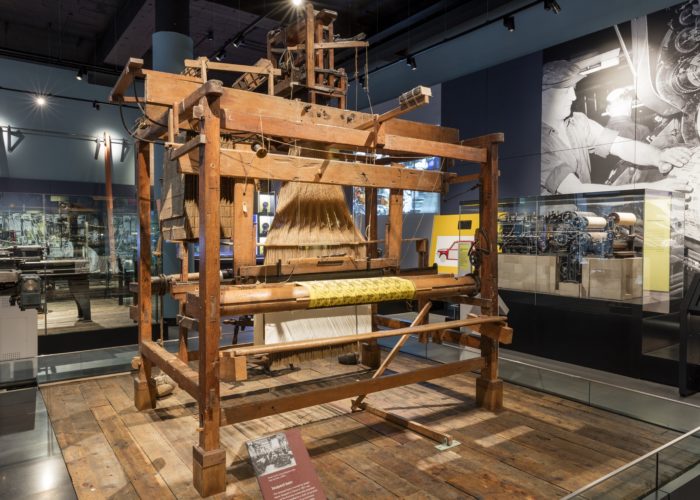Jacquard Loom
Theme: The impact of industry, Medicine, science and the people, Economic and technological revolution, Trade, tariffs and taxes, People in motion: exiles and opportunities
Before the 1800s, complex woven designs were created by hand. This was very labour-intensive. As a result, patterned fabric was extremely expensive. In 1804 Joseph-Marie Jacquard (1752 – 1834) developed the Jacquard Loom, which mechanised the production of patterned textiles. The loom contributed to the transformation of textile weaving from a ‘cottage industry’ run by close-knit families of skilled workers, to a focus of mass production on an industrial scale.
Inspired by an earlier loom designed by Jacques de Vaucanson, Jacquard worked on an important improvement. The loom itself remained unchanged, but Jacquard added a revolutionary new machine that used a series of punch cards to control the design and easily produce intricately patterned textiles.
The Jacquard attachment and cards allowed the loom worker to control (with extraordinary precision and speed) which threads were raised, to make a design appear. Firstly, a design was created on gridded paper. A skilled workman then took this drawing and translated the design onto a ‘punch’ card. Holes were punched into the card, whereby each column and row would correspond to a specific square of the design (like in the game ‘battleships’). These cards were then stitched together into a continuous belt and fed into the loom. By inserting punch cards, an operator could control the motion of the multitude of threaded rods in the loom. Rods allowed to fall through holes in the punch cards would lift vertical threads and allow the horizontal shuttle to pass through; holes that were blocked would remain in place, thus allowing for complex patterns.
Now lower skilled labourers could create equally beautiful products to skilled weavers, for a fraction of the price.
The Jacquard Loom was introduced in Britain in the 1820s. Now lower skilled labourers could create equally beautiful products to skilled weavers, for a fraction of the price. While this made textiles more affordable and generated huge profits for the mill owners, it also led to job losses for the skilled weavers. This sparked a hostile response from those who found their livelihoods threatened by the new labour-saving technology. A movement opposed to the mechanisation of industry known as the Luddite movement gained much momentum from the introduction of these looms. In a series of violent protests, mills were attacked and their looms destroyed.
But, as traditionally skilled workers lost their jobs to the Jacquard Loom, a new class of technically skilled workers began to replace them. The process of translating designs to the looms’ punch cards, and the maintenance and construction of the machines allowed for the employment of educated craftsmen and mechanists. These professional classes saw their lives improve as result and would be vital to the developing Industrial Revolution.
Did you know..?
Jacquard’s punch cards inspired Charles Babbage to use similar devices in his Analytical Engine – one of the first mechanical computers. As a form of early programming, these cards contained information for the device to carry out – just like coding today.
Use our Classroom resources to investigate this object and the Industrial Revolution further.
Highlights:
- Using objects, artworks and other sources to find out about the past
- Introducing the Age of Revolution
- How to make a revolutionary stop-frame animation
- Mystery objects
And much more…
Sources & acknowledgements
This object description and its related educational resources were researched and written by our team of historians and education specialists. For further information see the item’s home museum, gallery or archive, listed above.
-
Education overview
You can access a range of teachers resources related to this object and more on our education page.
Please also see our glossary of terms for more detailed explanations of the terms used.
-
Curatorial info
- Originating Museum: National Museums Scotland
- Accession Number: T.1934.241
- Production Date: 1821 - 1893
- Creator: Joseph Hood
- Material: Wood, Metal, Silk
- Creation Place: Newmilns, Ayrshire, Scotland
- Original record
-
Use this image
- Rights Holder: © National Museums Scotland
- License Type:
All rights reserved
Find it here
This object is in the collection of National Museum of Scotland



